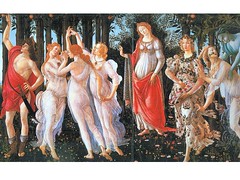Alessandro di Mariano di Vanni Filipepi, better known as Sandro Botticelli or Il Botticello ("The Little Barrel"; c. 1445[1] – May 17, 1510) was an Italian painter of the Florentine school during the Early Renaissance (Quattrocento). He worked under the patronage of Lorenzo de' Medici, says Wikipedia.
The masterworks Primavera (c. 1482) and The Birth of Venus (c. 1485) were both seen by Vasari at the villa of Lorenzo di Pierfrancesco de' Medici at Castello in the mid-16th century.
The complex meanings of these paintings continue to receive widespread scholarly attention, mainly focusing on the poetry and philosophy of humanists who were the artist's contemporaries.
The Adoration of the Magi for Santa Maria Novella (c. 1475-1476, now at the Uffizi) contains the portraits of Cosimo de' Medici ("the finest of all that are now extant for its life and vigour"),[5] his grandson Giuliano de' Medici, and Cosimo's son Giovanni.
In 1481, Pope Sixtus IV summoned Botticelli and other prominent Florentine and Umbrian artists to fresco the walls of the Sistine Chapel.
He returned to Florence, and "being of a sophistical turn of mind, he there wrote a commentary on a portion of Dante and illustrated the Inferno which he printed, spending much time over it."
In the mid-1480s Botticelli worked on a major fresco cycle with Perugino, Ghirlandaio, and Filippino Lippi, for Lorenzo the Magnificent's villa near Volterra; in addition he painted many frescoes in Florentine churches.
La Primavera is a huge painting. Such large-format works were not unusual in the private residences of affluent families. The Primavera is, however, significantly illustrative of Renaissance classicistic iconography and form, depicting classical gods almost naked and life-size and a complex philosophical symbolism requiring deep knowledge of Renaissance literature to interpret.
Subscribe to:
Post Comments (Atom)





No comments:
Post a Comment